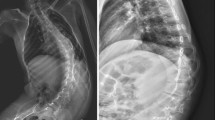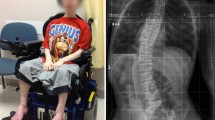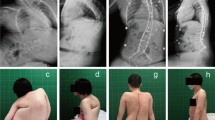Abstract
Between 2005 and 2007, 14 patients who had severe scoliosis in Duchenne muscular dystrophy (DMD) and a poor forced vital capacity (FVC) of <30% at admission underwent scoliosis surgery. FVC on admission was 21.6% (range, 16–27%). The patients were given respiratory muscle training using a pulmonary trainer (Threshold IMT, Philips Respironics, Inc.) for six weeks before operation. FVC increased to 26.2% (range, 22–31%) the day before operation. The mean preoperative scoliosis was 98° (range, 81°–130°). All patients underwent posterior fusion and all-screw construction and were extubated on the operative day. No patients developed any respiratory complications. The postoperative scoliosis was 34° (range, 20°–40°) (65%). FVC remained stable at six weeks after operation. FVC decreased to 19.8% (range, 16–25%) and the mean scoliosis was 35° (range, 23°–40°)(64%) at two years after operation. DMD patients with severe scoliosis and FVC considered too low to permit reasonable surgical risk could undergo surgery and could benefit from surgery.




Similar content being viewed by others
References
Askin GN, Hallettv R, Hare N, Webb JK (1997) The outcome of scoliosis surgery in the severely handicapped child: an objective and subjective assessment. Spine 22:44–50
Bach JR, Sabharwal S (2005) High pulmonary risk scoliosis surgery. J Spinal Disord Tech 18:527–530
Benson ER, Thomson JD, Smith BG, Banta JV (1998) Results and morbidity in a consecutive series of patients undergoing spinal fusion for neuromuscular scoliosis. Spine 23:2308–2317
Borg GA (1982) Psychophysical bases of perceived exertion. Med Sci Sports Exerc 14:377–381
Bridwell KH, Baldus KE, Iffrig TM (1999) Process measures and patient/parent evaluation of surgical management of spinal deformities in patients with progressive flaccid neuromuscular scoliosis. Spine 24:1300–1309
Brooke MH, Fenichel GM, Griggs RC, Mendell R, Moxley R, Florence J et al (1989) Duchenne muscular dystrophy: patterns of clinical progression and effects of supportive therapy. Neurology 39:475–481
Galasko CSB, Williamson JB, Delaney CM (1995) Lung function in Duchenne muscular dystrophy. Eur Spine J 4:263–267
Galasko CBS, Delany C, Morris P (1992) Spinal stabilisation in Duchenne muscular dystrophy. J Bone Joint Surg Br 74:210–220
Gill I, Eagle M, Mehta JS, Gibson MJ, Bushby K, Bullock R (2006) Correction of neuromuscular scoliosis in patients with preexisting respiratory failure. Spine 31:2478–2483
Hornstein S, Inman S, Ledsome JR (1987) Ventilatory muscle training in kyphoscoliosis. Spine 12:859–863
Hsu JD (1983) The natural history of spinal curve progression in the nonambulatory Duchenne muscular dystrophy patient. Spine 8:771–775
Kennedy JD, Staples AJ, Brook PD, Parsons DW, Sutherland AD, Martin AJ et al (1995) Effect of spinal surgery on lung function in Duchenne muscular dystrophy. Thorax 50:1173–1178
Klefbeck B, Nedjad JH (2003) Effect of inspiratory muscle training in patients with multiple sclerosis. Arch Phys Med Rehabil 84:994–999
Kurz LT, Mubarak SJ, Schultz P, Park SM, Leach J (1983) Correlation of scoliosis and pulmonary function in Duchenne muscular dystrophy. J Paediatr Orthop 3:347–355
McConnell AK, Romer LM, Weiner P (2005) Inspiratory muscle training in obstructive lung disease: how to implement and what to expect. Breathe 2:39–49
Oda T, Shimizu N, Yonenobu K, Ono K, Nabeshima T, Kyoh S (1993) Longitudinal study of spinal deformity in Duchenne muscular dystrophy. J Paediatr Orthop 13:478–488
Sakai DN, Hsu JD, Bonnett DA, Brown JC (1977) Stabilization of the collapsing spine in Duchenne muscular dystrophy. Clin Orthop 128:256–260
Shapiro F, Specht L (1993) The diagnosis and orthopaedic treatment of inherited muscular diseases of childhood. J Bone Joint Surg Am 75:439–445
Smith A, Koreska J, Mosley CF (1989) Progression of scoliosis in Duchenne muscular dystrophy. J Bone Joint Surg Am 71:1066–1074
Sticker U, Moser H, Aebi M (1996) Predominantly posterior instrumentation and fusion in neuromuscular and neurogenic scoliosis in children and adolescents. Euro Spine J 5:101–106
Sullivan JA, Conner SB (1982) Comparison of Harrington instrumentation and segmental spinal instrumentation in the management of neuromuscular spinal deformity. Spine 7:299–304
Sussman MD (1984) Advantage of early spinal stabilization and fusion in patients with Duchenne muscular dystrophy. J Paediatr Orthop 4:532–538
Topin N, Matecki S, Le Bris S (2002) Dose-dependent effect of individualized respiratory muscle training in children with Duchenne muscular dystrophy. Neuromuscul Disord 12:576–583
Wanke T, Toifl K, Merkle M, Formanek D, Lahrmann H, Zwick H (1994) Inspiratory muscle training in patients with Duchenne muscular dystrophy. Chest 105:475–482
Yamashita T, Kanaya K, Yokogushi K, Ishikawa Y, Minami R (2001) Correlation between progression of spinal deformity and pulmonary function in Duchenne muscular dystrophy. J Pediatr Orthop 21:113–116
Author information
Authors and Affiliations
Corresponding author
Additional information
Authors’ contributions
MT performed the clinical and radiological evaluation and analyses and drafted the manuscript. All authors edited and approved the final manuscript.
Rights and permissions
About this article
Cite this article
Takaso, M., Nakazawa, T., Imura, T. et al. Surgical management of severe scoliosis with high-risk pulmonary dysfunction in Duchenne muscular dystrophy. International Orthopaedics (SICOT) 34, 401–406 (2010). https://doi.org/10.1007/s00264-009-0764-7
Received:
Revised:
Accepted:
Published:
Issue Date:
DOI: https://doi.org/10.1007/s00264-009-0764-7




